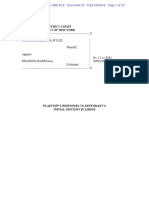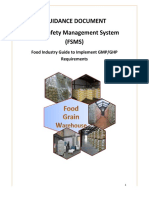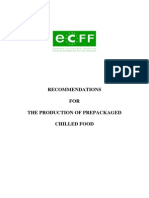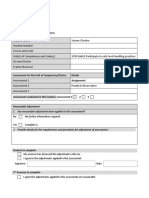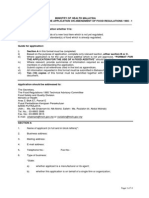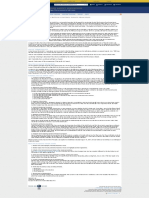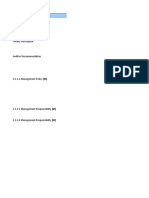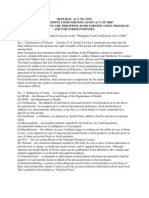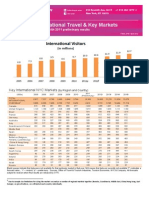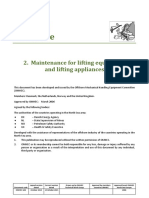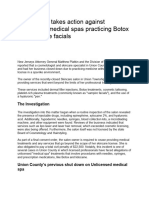Section B - Menu Review and Process Flow
Section B - Menu Review and Process Flow
Uploaded by
gvelaugosdeleonCopyright:
Available Formats
Section B - Menu Review and Process Flow
Section B - Menu Review and Process Flow
Uploaded by
gvelaugosdeleonOriginal Title
Copyright
Available Formats
Share this document
Did you find this document useful?
Is this content inappropriate?
Copyright:
Available Formats
Section B - Menu Review and Process Flow
Section B - Menu Review and Process Flow
Uploaded by
gvelaugosdeleonCopyright:
Available Formats
Rules and Regulations Food Service Chapter 290-5-14 Manual for Design, Installation and Construction
SECTION B MENU RIEW AND PROCESS FLOW
REFERENCES (Chapter 290-5-14) .02 Provisions. (1) (1) Permit (f) 2. and 3. Responsibilities of Permit Holder (2) (1) Permit (g) Notification of Menu Change (3) (3) Application for a Permit (b) Contents of Application (4) (4) When Plans Are Required (b) Submission of Plans (5) (5) When a HACCP Plan is Required (a) Categorization of Foods and (d) 1. Hazard analysis of menu items .04 Food. (1) (4) Protection From Contamination After Receiving (c) Packaged and Unpackaged Food Separated, Packaging, and Segregation 1. (i) and (ii) (2) (4) Protection From Contamination After Receiving (g) Washing Fruits and Vegetables 1. (3) (4) Protection From Contamination After Receiving (t) Food Preparation (4) (4) Protection From Contamination After Receiving (z) Miscellaneous Sources of Contamination .05 Equipment and Utensils. Amended. (1) (6) Maintenance and Operation (f) Warewashing Sinks, Use Limitation. 2. .08 Special Food Service Operations. (1) (2)Temporary Food Service Establishments (a) Operation, Permit Application, Responsibilities 3. Vendor Application (ii) .10 Compliance Procedures (2) Inspections (a) Risk Categorization
I. Conducting a Menu List Review: 1. The menu is an integral part of the Plan Review Process. A menu delineating all of the food and beverage items to be offered at the food service establishment must be submitted by the applicant to the Health Authority with the submission of the Plan Review document (see Part II, Section K entitled, Forms and Documents, Form K-5 within the Interpretation Manual for the Rules and Regulations Food Service Chapter 290-5-14 ). Conducting a review of the menu list also allows the reviewer to establish plan review priorities by identifying:
Page B1 of B27
Rules and Regulations Food Service Chapter 290-5-14 Manual for Design, Installation and Construction
A. High-risk foods or high-risk food preparation processes; and B. Operational steps requiring further inquiry such as receiving, preparation, cooking, cooling and reheating. 2. By identifying high-risk foods or high-risk food preparation processes, one can focus his or her attention on needed types of equipment and their arrangement along with the associated physical facilities as they relate to those foods or processes that will most likely cause, if uncontrolled, foodborne illness. These foods might include high-risk foods products like raw chicken that naturally carry a high pathogenic load. If such products are used in a facility, equipment design and arrangement related to cross-contamination and cooking should be a priority during the plan review. If there are foods that go through the temperature danger zone several times, equipment and facility arrangement relating to cooling, holding and reheating practices should be carefully reviewed. If the establishment is primarily a "Cook and Serve" operation, then time can best be spent on ensuring proper equipment design and arrangement to enhance adequate cooking of foods. 3. As with the inspection process, the plan review process should focus on the food and what will happen to the food as it flows through receipt, storage, preparation and service. The source and quantity of food to be served should be reviewed along with the preparation and post-preparation operations and the proposed storage practices. It is imperative to have knowledge of this information so that a proper assessment of the physical facilities can be made. In addition, food preparation processes should be evaluated to determine the types and volumes of foods to be prepared and the Risk Type associated with the establishment Risk Type I, II or III. The Risk Type of establishment will be determined based on: A. (Risk Type I) - No cooking of any food taking place. May reheat commercially prepackaged precooked foods such as hotdogs and sausages. B. (Risk Type II) - Foods that are prepared onsite will be cooked and/or held and/or reheated. C. (Risk Type III) - Food processing varies from the requirements found within the current Georgia Food Service Rules and Regulations Chapter 290-5-14 and as a result, a Hazard Analysis Critical Control Point (HACCP) plan is required to prove the food can be safely prepared and served within the establishment. Both the Georgia Department of Human Resources Environmental Health and Injury Control Branch and the County Health Department Environmental Health must approve this HACCP plan before the particular food item can be included within the menu and the approval of said plans and specifications may be delayed until such approval occurs. 4. Layout, flow and menu (including food preparation processes) should be major considerations to help facilitate a food service establishment operators Active Managerial Control (AMC) of the risk factors for foodborne illness. Strategic layout and placing of facilities and equipment will separate different food preparation processes, a major step
Page B2 of B27
Rules and Regulations Food Service Chapter 290-5-14 Manual for Design, Installation and Construction
towards preventing contamination of food that may result from poor personal hygiene, contaminated equipment, and improper holding temperatures. Adequate and convenient storage will also enhance operations. The menu and methods of food preparation are the key elements in the layout and flow of the establishment. 5. Food preparation processes should be evaluated to determine the types and volumes of foods to be prepared. Special attention should be given to the review of complex food processes that will involve: A. Multiple ingredients being assembled or mixed. B. Potentially hazardous foods (time/temperature control for safety foods). C. Foods that will be prepared or held for several hours prior to service. D. Foods requiring cooling and reheating. E. Multiple step processing (passing through the critical temperature zone - (135F to 41F more than once). 6. In the review and evaluation of food processing steps, the environmentalist will most likely need to request recipes for additional information as to how foods are to be processed. Should potential hazardous food processing vary from that required within the Georgia Food Service Rules and Regulations Chapter 290-5-14, a Hazard Analysis Critical Control Point (HACCP) plan and a variance request to the Department must accompany the menu item (see Section B subsection B (5) When a HACCP Plan is required: of Part-I and Section J of Part-II of the Interpretation Manual for Rules and Regulations Food Service Chapter 290-5-14). The HACCP plan must enumerate at least the following information: A. A categorization of the types of potentially hazardous foods that are specified in the menu such as soups and sauces, salads and bulk solid foods such as meat roasts or other foods that are specified by the Health Authority. B. A flow diagram by specific food or category type that identifies critical control points and provides information on ingredients, materials and equipment used in the preparation of that food and formulations or recipes that delineate methods and procedural control measures that address the food safety concerns involved. C. A food service manager and employee training plan that addresses the food safety issues of concern. D. A statement of standard operation procedures for the plan under consideration including clearly identifying:
Page B3 of B27
Rules and Regulations Food Service Chapter 290-5-14 Manual for Design, Installation and Construction
(1.) Each critical control point the point within the food flow pattern where absolute control must be maintained to reduce hazards to safe levels or eliminated them, (2.) The critical limits for each critical control point the intercessions or control limits whereby hazards are reduced to safe levels or they are eliminated, (3.) The method and frequency for monitoring and controlling each critical control point by the food employee designated by the person in charge, (4.) Action to be taken by the person in charge if the critical limits or intercessions for each critical control point are not met, and (5.) The method and frequency for the person in charge to routinely verify that the food employee is following standard operating procedures and monitoring critical control points, (7.)Records to be maintained by the person in charge to demonstrate that the HACCP plan is properly operated and managed. E. Additional scientific data or other information, as required by the Health Authority, supporting the determination that food safety is not compromised by the proposal. This additional scientific data may include third party independent testing of the final product as per the HACCP plan by a certified laboratory. 7. The menu for a food service establishment dictates the space and equipment requirements for the safe preparation and service of various food items. This dictation is conducted with consideration of variation in time/temperature cooking requirements due to varying bacterial loads on different species of animal derived foods. In addition, consideration must be given for separation in space and equipment requirements due to possibilities of cross contamination and whether or not foods will be consumed raw or undercooked. This is necessary to reduce harmful bacteria loads or to prevent the increase of harmful bacteria loads on foods. For example, should fish or shrimp have to be thawed at the same time as vegetables are to be washed, separate sinks will be required in order to separate each preparational step from the other to prevent cross-contamination of ready-to-eat foods with contaminants from raw product. In this example, the fish will require a higher cooking temperature (145F/15 seconds) where as the vegetables would only require 135F/15 seconds for hot holding. In addition, the vegetables could also be consumed raw, resulting with the only protection against foodborne illness of these ready-to-eat foods being thorough washing procedures and no bare hand contact after washing - (see Rule 290-5-14-.04 subsections (4) (g) 1. and (5)). For another example, since fish/seafood require different time/temperature parameters from that of raw chicken, separate food preparation sinks may be necessary to wash or thaw these items - (see Rule 290-5-14-.04 subsections (4) (c) 1 (ii) and (5)). With these parameters, it is obvious that the layout and design of the facilities will need to be considered to prevent cross-contamination potentials. With cross-contamination
Page B4 of B27
Rules and Regulations Food Service Chapter 290-5-14 Manual for Design, Installation and Construction
prevention and time/temperature control requirements in mind, the menu will determine if the proposed receiving and delivery areas, storage area, preparation and handling areas and thawing, cooking, and reheating areas are available and adequate to handle the types and volumes of foods being served. 8. A kitchen, in itself, is static; objects (equipment) are arranged in a fixed pattern. In operation, a kitchen becomes a flow of food and people in and around the fixed objects. It is this fluid pattern that proves the intelligence of a good layout. The sequence of flow in a food facility usually assumes one of two basic arrangements: 1. Assembly Line Flow can be in several configurations (i.e., circular, L-shaped, Parallel, or U-shaped) and 2. Functional Flow is described as where the work processes are arranged in departments (i.e., vegetable, meat, bakery, assembly, etc.). When looking at the menu, evaluate the flow patterns for the preparation of foods to be served to be sure that the layout of the facility provides an adequate separation of raw ingredients from ready-to-eat foods and that the traffic patterns are not crossing paths with waste items and other sources of contamination. See Illustration B-1 entitled, Functional Flow and Subsection II entitled, Determining Process Flows on this page for more information. Likewise, see Illustration B-2 on page B18 as well. ILLUSTRATION B-1 Functional Flow (Typical Floor Plan Showing Food Flow Patterns as it relates to Equipment Layout)
Page B5 of B27
Rules and Regulations Food Service Chapter 290-5-14 Manual for Design, Installation and Construction
II. Determining Process Flows: 1. Every establishment has some type of set pattern of procedures even if it is simply described as "the way we do things." A small, independent operation may not have written procedures, yet it may have adequate procedures that are routinely followed. Good communication is required to discover these types of informal management systems. 2. Food service establishments may implement effective food safety management systems by establishing controls for the food preparation methods and processes common to their operation. Control of food preparation processes rather than individual food items is often called the "process approach" to HACCP. The process approach, using the principles of HACCP, can best be described as dividing the many food items in an operation into three food preparation processes then analyzing the risk factors associated with each process. This operational step establishes the flow of food pattern through the establishment and they serve as the foundation for analyzing and controlling hazards. 3. The flow of food in a food service establishment is the path that food follows from receiving through service to the customer. Several activities or stages make up the flow of food and are called operational steps. Examples of operational steps include receiving, storing, preparing, cooking, holding, cooling, serving and reheating can be found within Example B-1. 4. Most food items produced in the food service establishment can be categorized into one of three preparation processes based on the number of times the food passes through the temperature danger zone (42 F to 134 F): A. Process 1: Food Preparation with No Cook Step:
Example flow: Receive - Store - Prepare - Hold - Serve (Other food flows are included in this process, but there is no cook step to destroy pathogens while in the food service facility. It should be noted that these are ready-to-eat foods that might inter the temperature danger zone but do not go all the way through it. An example would be making tuna salad from room temperature ingredients of which the finished product will be cooled prior to service.) Examples: salads, deli meats, cheeses, sashimi, raw oysters
B. Process 2: Preparation for Same Day Service:
Example flow: Receive - Store - Prepare - Cook - Hold - Serve (Other food flows are included in this process, but there is only one trip through the temperature danger zone) Examples: Hamburgers, fried chicken, hot dogs
C. Process 3: Complex Food Preparation:
Example flow: Receive - Store - Prepare - Cook - Cool - Reheat - Hot Hold - Serve (Other food flows are included in this process, but there are always two or more complete trips through the temperature danger zone) Examples: refried beans, leftovers
Page B6 of B27
Rules and Regulations Food Service Chapter 290-5-14 Manual for Design, Installation and Construction
EXAMPLE B-1 No Cook Step Receiving Same Day Service Receiving Complex Food Preparation Receiving Cooling
Storing
Storing
Storing
Reheating
Preparing
Preparing
Preparing
Holding
Holding
Cooking
Cooking
Serving
Serving
Holding
Serving
Page B7 of B27
Rules and Regulations Food Service Chapter 290-5-14 Manual for Design, Installation and Construction
5. The style of food service should also be reviewed. The style of food service may be cookto-order (cook-serve), self-serve (buffet or salad bar), service of pre-packaged foods, service of large volumes of food (institutions and catering operations), food preparation requiring multiple steps and handling, etc. All of these will have special needs as to layout, arrangement and types of equipment as well as how food is processed and handled by food employees. These considerations must be explored during the menu review. 6. The system of menu evaluation involves the review of categories of foods and their required preparation, i.e.: A. All food is required to be obtained from sources that comply with Law (Federal and State, which ever is applicable). Specifically, this means that food received by a food service establishment has been inspected and approved for distribution by a governmental agency having jurisdiction of food distribution in commerce. B. Thin meats such as poultry, fish, eggs (hamburgers, sliced meats, & fillets) C. Thick meats and whole poultry (roast beef, whole turkey, whole chickens, & hams) D. Cold processed foods (salad, sandwiches, vegetables) E. Hot processed foods (soups, stews, casseroles) F. Bakery goods 7. The system (Process Approach) is very useful since the critical control points for each process remain the same regardless of the individual menu ingredients. 8. A summary of the three food preparation processes in terms of number of times through the temperature danger zone can be depicted in a Danger Zone diagram. Note that while foods produced using process 1 may enter the danger zone, they are neither cooked to destroy pathogens, nor are they hot held. Foods that go through the danger zone only once are classified as Same Day Service, while foods that go through more than once are complex. See the following Diagram B-1:
Page B8 of B27
Rules and Regulations Food Service Chapter 290-5-14 Manual for Design, Installation and Construction DIAGRAM B-1 Trips through the Danger Zone No Cook Step 135F NO TRIP ONE COMPLETE TRIP 41F COMPLETE AT LEAST TWO COMPLETE TRIPS Same Day Service Complex Food Preparation
9. The three food preparation processes (or system) conducted in food service establishments are not intended to be all-inclusive. For instance, quick service facilities may have "cook and serve" processes specific to their operation where foods are immediately served to the consumer after cooking. These processes are likely to be different from the "Same Day Service" preparation processes in full service restaurants since many of their foods are generally cooked and hot held before service. It is also very common for a food service operator to have a single item like a chicken salad sandwich that is created using several components that may be produced using more than one kind of food preparation process. It is important to remember that even though variations of the three food preparation process flows are common, the control measures actions or activities that can be used to prevent, eliminate, or reduce food safety hazards - to be implemented in each process will generally be the same based on the number of times the food goes through the temperature danger zone. The system is very useful since the critical control points for each process remain the same regardless of the individual menu ingredients. 10. To demonstrate the above concepts, we will examine Process 3, multiple passes through the temperature danger zone by considering how chicken salad can be prepared. To prepare chicken salad from scratch, the ingredients would be raw chicken, eggs, mayonnaise, pickles, onions, celery and seasoning. The raw chicken and eggs would have to be cooked and cooled for latter preparation, which would call for adequate cooking and refrigeration equipment or perhaps, facilities such as compartmented food preparation sink for ice-bath cooling methods. The celery and onions would have to be washed in a dedicated sink for the strict purpose of washing fruits and vegetables. An adequately equipped handwashing sink station would be required within the food preparation area to encourage the frequent washing of the food employees hands. In addition to the provision for handwashing, equipment, such as at least a properly sized 3-compartmented sink as required by Chapter 290-5-14, would be needed to clean and sanitize equipment and utensils used to prepare the ingredients between tasks. These facilities, handwashing sink and equipment and utensil washing and sanitizing facilities, serve to do one thing and that is to prevent cross-
Page B9 of B27
Rules and Regulations Food Service Chapter 290-5-14 Manual for Design, Installation and Construction contamination of the ready-to-eat chicken salad from occurring. All these planning steps would help to enable the food service establishment operator to control or eliminate the hazards associated with the preparation of the chicken salad. These hazards being: A. Some of C. perfringens surviving the cooking process by means of spore formation. This is why cooking equipment must be capable of raising the raw chicken and eggs through the danger zone, which is between 135F and 41F, quickly to 165F for at least 15 seconds to kill harmful vegetative bacteria associated with the raw ingredients. B. Controlling vegetative outgrowth of spore forming bacteria such as C. perfringens and B. bacillus, during the cooling process that may have survived the cooking process. This is why the proposed food service establishment plans would need conveniently located and adequately sized cooling equipment such as walk-in coolers and/or food preparation sinks so that cooked chicken and eggs can be quickly cooled to below 41F before salad ingredient assembly (or salad preparation). C. Cross-contamination of ready-to-eat chicken salad during the preparation process where cooked chicken and eggs are being handled with Shigella, Hepatitis A virus, Norwalk like viruses or E. Coli that could come from contaminated food handler hands via the fecal oral route. This is why the food service plans would need to show an adequate equipped handwashing station near the food preparation area and adequate designed and equipped equipment and utensil cleaning and sanitizing facilities to help prevent such cross-contamination. In addition and in conjunction with hand washing, the prerequisite program (or Standard Operation Program SOP) of good employee health and no bare hand contact with ready-to-eat foods will also greatly enhance the prevention of fecal oral pathogen route of cross contamination of food. III. The Hazard Analysis: 1. In the "process approach" to HACCP, conducting a hazard analysis on individual food items is time and labor intensive and is generally unnecessary. Identifying and controlling the hazards in each food preparation process listed within subsection IV, Determining Risk Factors by Evaluating Process Flows, achieves the same control of risk factors as preparing a HACCP plan for each individual product. 2. For an example, an establishment has dozens of food items (including baked chicken and meatloaf) in the "Preparation for Same Day Service" category. Each of the food items may have unique hazards but regardless of their individual hazards, control via proper cooking and holding will generally ensure the safety of all of the foods in this category. An illustration of this concept follows: A. Even though they have unique hazards, baked chicken and meatloaf are items frequently grouped in the "Same Day Service" category (Process 2). B. Salmonella and Campylobacter, as well as spore-formers, such as Bacillus cereus and Clostridium perfringens, are significant biological hazards in chicken.
Page B10 of B27
Rules and Regulations Food Service Chapter 290-5-14 Manual for Design, Installation and Construction C. Significant biological hazards in meatloaf include Salmonella, E. coli O157:H7, Bacillus cereus, and Clostridium perfringens. D. Despite their different hazards, the control measure used to kill pathogens in both these products is cooking to the proper temperature. E. Additionally, if the products are held after cooking, then proper hot holding or time control (i.e., time as a public health control) is also necessary to prevent the outgrowth of sporeformers that are not destroyed by cooking. 3. As with product-specific HACCP, critical limits for cooking remain specific to each food item in the process. In the scenario described above, the cooking step for chicken requires a final internal temperature of 165 F for 15 seconds to control the pathogen load for Salmonella. Meatloaf, on the other hand, is a ground beef product and requires a final internal temperature of 155 F for 15 seconds to control E. coli O157:H7. To control the pathogen load for both Salmonella and E. coli O157:H7, a final internal temperature of 165 F for 15 seconds would be needed, since 165 F for 15 seconds is the higher more restrictive of the two temperatures. Note that there are some operational steps, such as refrigerated storage or hot holding that have critical limits that apply to all foods. 4. The following Table B-1further illustrates this concept. Note that the only unique control measure applies to the critical limit of the cooking step for each of the products. Other food safety hazards and control measures may exist that are not depicted here: TABLE B-1 Process 2: Preparation for Same Day Service:
Baked Meatloaf Salmonella Example Biological E. coli *015-H7 Hazard Bacillus cereus Various fecal-oral route pathogens Refrigeration 41F or below Cooking at 155F for 15 seconds Example Control: Hot Holding 135F or above OR Critical Limit (CL) Time Control for 4 hours or less found with Rules No bare hand contact with RTE and Regulations food, proper handwashing, exclusion/restriction of ill employees
Example Product
Baked Chicken Salmonella Campylobacter Bacillus cereus Various fecal-oral route pathogens Refrigeration 41F or below Cooking at 165 F for 15 seconds Hot Holding 135F or above OR Time Control for 4 hours or less No bare hand contact with RTE food, proper handwashing, exclusion/restriction of ill employees
Page B11 of B27
Rules and Regulations Food Service Chapter 290-5-14 Manual for Design, Installation and Construction
IV. Determining Risk Factors by Evaluating Process Flows: 1. Several of the most common risk factors associated with each food preparation process are discussed below. It must be remembered that while the generally focus of the plan review must be on ensuring the proposed plans incorporate the required equipment layout and facilities to reduce or eliminate these risk factors, there may be other risk factors unique to an operation or process that are not listed here. One should evaluate each operation and food preparation process independently. 2. In order to have active managerial control over personal hygiene and cross-contamination, the physical facility design and layout must enable an operator to implement control measures in all phases of the operation. The following items should be evaluated during the plan review regardless of the food preparation process used: A. Adequate utensils and equipment to facilitate no bare hand contact with RTE (Ready-toEat) foods to help prevent the transfer of viruses, bacteria, or parasites from hands to ready-to-eat foods. B. Proper hand washing facilities to help prevent the transfer of viruses, bacteria, or parasites from hands to food. C. Restriction or exclusion of ill employees to help prevent the transfer of viruses, bacteria, or parasites from hands to food. D. Proper type and arrangement of equipment to prevent cross-contamination of ready-toeat food or clean and sanitized food contact surfaces with soiled cutting boards, utensils, aprons, etc., or raw animal foods. 3. To access potential hazards associated with items listed within the menu, the reviewer will need to first determine the process flow and then, determine the potential hazard for each operational step of the process flow. Examples of hazard analysis for each of the three process flows are as follows: A. Food Preparation Process 1 - Food Preparation with No Cook Step: Example Flow: RECEIVE - STORE - PREPARE - HOLD SERVE (1.) This particular process represents several food flows. Many of these food flows are common to food service facilities. Raw, ready-to-eat food, such as sashimi, raw oysters, and salads, are grouped in this category. Components of these foods are received raw and will not be cooked prior to consumption. Foods cooked at the processing level but that undergo no further cooking at the food service establishment level before being consumed are also represented in this category. Examples of these kinds of foods are deli meats, cheeses, and other pasteurized products.
Page B12 of B27
Rules and Regulations Food Service Chapter 290-5-14 Manual for Design, Installation and Construction
(2.) All the foods in this category lack a kill (or cook) step while at the food service establishment. In other words, there is no complete trip made through the danger zone for the purpose of destroying pathogens. During the plan review, the reviewer can help to ensure that the food received in the facility is as safe as possible by reminding the establishment permit applicant to ensure that the food is received in good condition, at proper temperatures and from approved sources. Without a kill step to destroy pathogens, the primary responsibility of the operator will be to prevent further contamination by ensuring that employees follow good hygienic practices. In addition, equipment type, number and arrangement must be adequate to prevent cross contamination by properly storing products away from raw animal foods and soiled equipment and utensils. Foodborne illness may result from ready-to-eat food being held at unsafe temperatures for long periods of time due to the outgrowth of bacteria. (3.) A plan review involving this food preparation process should focus on ensuring that the physical facility design and layout must enable an operator to have active managerial control over the following: (a.) Cold holding or using time alone (i. e., time as a public health control) to inhibit bacterial growth and toxin production (b.) Food source (especially for shellfish due to concerns with viruses, natural toxins, and Vibrio and for certain marine finfish intended for raw consumption due to concerns with ciguatera toxin) (c.) Receiving temperatures (especially certain species of marine finfish due to concerns with scombrotoxin) (d.) Date marking of RTE PHF/TCS held for more than 24 hours to control the growth of Listeria monocytogenes (e.) Freezing certain species of fish intended for raw consumption due to parasite concerns; and (f.) Cooling from ambient temperature prevent the outgrowth of spore-forming or toxin-forming bacteria.
B. Food Preparation Process 2 - Preparation for Same Day Service: Example Flow: RECEIVE - STORE - PREPARE - COOK - HOLD SERVE (1.) In this food preparation process, food passes through the danger zone only once in the food service facility before it is served or sold to the consumer. Food is usually cooked and held hot until served, i.e. fried chicken, but can also be cooked and served immediately. A plan review involving this food preparation process should
Page B13 of B27
Rules and Regulations Food Service Chapter 290-5-14 Manual for Design, Installation and Construction focus on ensuring that the physical facility design and layout will support active managerial control over the following: (a.) Cooking to destroy bacteria and parasites; and (b.) Hot holding or using time alone (Time as a Public Health Control) to prevent the outgrowth of spore-forming bacteria. (c.) Food source and receiving temperatures/cold holding prior to cooking are also important if dealing with certain marine finfish due to concerns with ciguatera toxin and scombrotoxin (note: these toxins can not be eliminated by cooking).
C. Food Preparation Process 3 - Complex Food Preparation: Example Flow: RECEIVE - STORE - PREPARE - COOK - COOL - REHEAT - HOT HOLD SERVE (1.) Foods prepared in large volumes or in advance for next day service usually follow an extended process flow. These foods will pass through the temperature danger zone more than one time; thus, the potential for the growth of spore-forming or toxigenic bacteria is greater in this process. Failure to adequately control food product temperatures is one of the most frequently encountered risk factors contributing to foodborne illness. In addition, foods in this category have the potential to be recontaminated with Listeria monocytogenes, which could grow during refrigerated storage. The key to managing the operational steps within this food preparation process is to minimize the time foods are at unsafe temperatures and the prevention of cross-contamination of ready-to-eat foods by way of unclean hands and or unclean equipment and utensils. (2.) A plan review involving this food preparation process should focus on ensuring that the facility has adequate equipment that is properly arranged to support active managerial control over the following: (a.) Equipment for cooking to destroy bacteria and parasites; (b.) Equipment such as food sinks, ice paddles and adequately sized refrigeration for cooling to prevent the outgrowth of spore-forming or toxin-forming bacteria; (c.) Equipment to facilitate hot and cold holding or using time alone (or time as a public health control) to inhibit bacterial growth and toxin formation; (d.) SOPs (Standard Operating Practices) for date marking of ready-to-eat potentially hazardous (PHF/TCS) foods held for more than 24 hours to control the growth of Listeria monocytogenes;
Page B14 of B27
Rules and Regulations Food Service Chapter 290-5-14 Manual for Design, Installation and Construction
(e.) Equipment for reheating or for hot holding, if applicable, to prevent the outgrowth of spore-forming or toxin-forming bacteria; (f.) Equipment and facilities to ensure proper cleaning and sanitization of facilities and food contact surfaces; and
(g.) Food source and receiving temperatures/cold holding prior to cooking are also important if dealing with certain marine finfish due to concerns with ciguatera toxin and scombrotoxin. V. Summarization: 1. The menu for a food establishment dictates the space and equipment requirements for the safe preparation and service of various food items. The menu will determine if the proposed receiving and delivery areas, storage areas, preparation and handling areas, and thawing, cooking and reheating areas are available and adequate to handle the types and volumes of foods being prepared and served. It has a tremendous influence on the design and success of a food operation. From a design and layout perspective, these are just some of the factors determined by the menu: A. Dictates the amount of space required for the facility A complex menu requires more space to prepare than a limited or simple menu does, because separate workstations and additional equipment are necessary. Dictates service area size and design The greater the number of menu items, the more area required for service. For example, in a cafeteria each beverage requires a dispenser and each entre a point of service. Dictates warewashing facility size and dish machine capacity Complex menus often require multiple plates, dishes, and utensils, and so the warewashing area and warewashing machine capacity will need to be greater than in the case of simple menus. Dictates types of cooking equipment Complex menus require multiple types of equipment, especially in the final preparation area, where it may be necessary to steam, fry, bake, broil, and saut. Dictates equipment capacity Limited menus may require relatively few pieces of equipment but need large capacities of each. Complex menus may require many different types of equipment with relatively small capacities. Dictates size of dry and refrigerated storage areas Complex menus may require larger storage areas to maintain the par stocks necessary to meet demand.
B.
C.
D.
E.
F.
Page B15 of B27
Rules and Regulations Food Service Chapter 290-5-14 Manual for Design, Installation and Construction G. Dictates number of employees Simple menus require fewer employees than do complex menus. Dictates amount of investment required When large or complex menus require more equipment, space, and employees, costs rise.
H.
2. Menus will emphasize the importance of Flow and Layout within the proposed establishment. With thorough analysis of how food flows through the establishment and with proper layout of equipment according the food flow analysis, the following can be achieved: A. B. C. D. E. F. Preparation time is minimized; Proper Hygiene is easier to maintain; Less chance for cross contamination; Cleaning and sanitizing is much easier; Less confusion in workspace; and Easier to regulate (inspect).
3. Without proper flow and layout of food and equipment analysis, the opposite results occur: A. B. C. Preparation processes are negatively influenced, and or interrupted; Processes and procedures within the facility interfere with each other; Prep time goes up - potentially hazardous foods stay in the danger zones longer; Problems with a poor flow and layout; and Proper hygiene practices are affected.
D. E.
4. The importance of flow, layout and menu review is to accomplish public healths goal of ensuring the facility is designed to protect food as it travels through the facility through active managerial control of risk factors of which are: A. B. C. Food from unsafe sources; Inadequate cooking of potentially hazardous foods; Improper holding/time-temperature of potentially hazardous food;
Page B16 of B27
Rules and Regulations Food Service Chapter 290-5-14 Manual for Design, Installation and Construction
D. E.
Contaminated equipment; and Poor personal hygiene.
5. While examining the flow of food in a food establishment, the reviewer should concentrate his or her efforts on specific food flow areas and the methods used in controlling the inherent hazards specific to each area. 6. Its the menu plus the understanding of that menu which allows the food service establishment plan designer and the environmental health specialist to assess whether the facilities layout, flow & equipment is sufficient to ensure that food is protected as it travels through the food service establishment. 7. When reviewing the menu, it is important to evaluate the flow patterns for the preparation of the food to be sure that the layout of the facility provides an adequate separation of raw ingredients from ready-to-eat foods, and that the traffic patterns are not crossing paths with waste items and other sources of contamination. Cross contamination can be minimized when the flow of food is considered during plan review. See the following Illustration B-2:
Page B17 of B27
Rules and Regulations Food Service Chapter 290-5-14 Manual for Design, Installation and Construction ILLUSTRATION B-2
Areas of Congestion Potential for Cross Contamination
Legend Red = Foods to be Prepared (Receiving to Service Door to Table) Green = Ready-To-Eat Foods (Receiving to Service Door to Table) Blue = Dishes (Table to Dishwashing) Black = Trash (Trash Can to Dumpster or Solid Waste Storage Area) Circle in Blue all HANDWASHING SINKS Page B18 of B27
Rules and Regulations Food Service Chapter 290-5-14 Manual for Design, Installation and Construction
8. With a proper understanding of the menu and flow, the plans for food establishments can be reviewed to help assure that the food items being considered can be protected during all aspects of the food operation. 9. The following Table B-2 will illustrate the direct link to process control with risk factors:
TABLE B-2 Inherent Risk and Control Measures of Process Flows No Cook Step Preparation for Preparation for (Preparation of Same Day Service Complex Food Cross Contamination
Ready-to-Eat Foods)
Risk
Cross Contamination Survival of Pathogens
Cross Contamination Survival of Pathogens Growth of Pathogens
Controls
Hand Washing Separate RawAnimal Foods from Others Clean & Sanitize Equipment
Cooking Time/Temperatures Hot Holding
Cooking Holding Cooling Re-heating
Page B19 of B27
Rules and Regulations Food Service Chapter 290-5-14 Manual for Design, Installation and Construction
10. The following will illustrate how to review a menu and place each item in its process step:
Page B20 of B27
Rules and Regulations Food Service Chapter 290-5-14 Manual for Design, Installation and Construction
A.
The following are select descriptions of how the menu items are processed as they correspond to the R. T. Menu items as listed on Page B20. These process descriptions may be obtained in the form of recipes or general description of how the menu items are handled by food employees from the food service permit applicant during the plan review process. Once the description of the process flows for the menu items have been obtained, then the foods are placed into the appropriate columns for each process step based upon how many trips the food items make through the temperature danger zone. For an example, see Worksheet B-1 on page B22. Here, the reviewer will find the corresponding item numbers as listed on R. T. Menu listed on Page B20. The following are recipe descriptions of these numbered menu items: (1.) Chicken Meals - Whole, raw chickens are cooked on the rotisserie throughout the day and hot held. They are either: (a) sold whole, (b) sold as or chicken meals or family meals, or (c) used to prepare chicken potpies by pulling the meat off the bone and refrigerating until needed. Chickens prepared to be sold whole or in meals that are not sold within 2 hours are also used to make chicken potpies, stuffing, or chicken noodle soup by pulling the meat off the bone and refrigerating the meat until needed. PROCESS 2 Whether sold in family meals, individual meals, or whole, these chickens are cooked and hot held only, so they only go through the danger zone once. (2.) Meatloaf Meal - Meatloaf is made from raw ground beef, breadcrumbs, spices, etc. and cooked in small loaves and hot held. The meatloaf is sold whole or sliced for meals. Meatloaf that is not sold within two hours is rapidly cooled [whole loaves are sliced] and refrigerated to make meatloaf sandwiches the following day. PROCESS 2 This meatloaf, in meals or sold whole, is cooked and hot held and therefore makes only one trip through the danger zone. (3.) Hearth Ham - The hearth ham is fully cooked, commercially processed ham that is sliced and warmed to be sold by the pound or in individual meals. PROCESS 1 Commercially processed RTE foods can be served at any temperature, therefore this product has no cook step and does not truly make any trip through the danger zone. (4.) Rotisserie Turkey Meal - Whole, raw turkeys are cooked on the rotisserie throughout the day and hot held. They are carved and either sold in individual meals or by the pound. Any of this turkey that has not sold in two hours is rapidly cooled and stored for making turkey rice soup.
Page B21 of B27
Rules and Regulations Food Service Chapter 290-5-14 Manual for Design, Installation and Construction
PROCESS 2 This turkey is cooked and hot held, making only one trip through the danger zone. (5.) Chicken Carver Sandwiches - Fully cooked, commercially processed rounds of chicken breast meat are sliced for making sandwiches. The chicken breast meat is heated or prepared cold for the sandwiches as requested by the customer. PROCESS 1 This produce does not make a trip through the danger zone because it is RTE food and may be served at any temperature. (6.) Meatloaf Carver - Left over meatloaf that was not sold the previous day either whole or in meals is removed from the reefer and used to make meatloaf sandwiches. The meatloaf is reheated and hot held for making sandwiches unless otherwise requested by the customer. PROCESS 3 Cooked, cooled, and possibly reheated constitutes two or more trips through the danger zone. WORKSHEET B-1 Menu/ Flow Analysis Process Worksheet Process 1 Foods Foods that do not require a cook step (RTE) Process 2 Foods Foods that involve a cook step but only go through the danger zone once (Same day service) Process 3 Foods Foods that require complex preparation (Cook, Cool, Re-Heat)
3 Hearth Ham 5 Chicken Carver Sandwiches
1 Chicken Meals 2 Meatloaf Meal 4 Rotisserie Turkey Meal
6 Meatloaf Carver
B. One thing to remember before starting the menu review. In helping to prevent confusion, it is necessary to think about each of the menu items individually. In determining the process category, consider only one individual menu item at a time. It is easy to get confused if one thinks too far past the service of an individual menu item. This is an important part of the review process, because thats what is needed to understand what an individual is to do in his or her food service assessments (i. e., inspections) anyway. For example, the description may say that Product A is cooked, hot held, and served, then the leftovers are used to later prepare product B, but that Page B22 of B27
Rules and Regulations Food Service Chapter 290-5-14 Manual for Design, Installation and Construction
doesnt mean that Product A falls under Process 3. It still only went through the danger zone once, so it belongs in Process 2 and cooking and hot holding are the control measures. C. The EHS should only look at the flow of each menu item from receipt to service. If he or she follows this reminder from the very beginning of the menu review process, it will help the EHS to complete a proposed food service establishments plan and specification review process in a more efficient and accurate manner.
11. Equipment and facilities can be evaluated by following the food flow processes. Specific key equipment should be present to control each inherent risk noted in Table B-2 on page B19 for each process step as indicated within Charts B-1, B-2 and B-3 that follows:
Page B23 of B27
Rules and Regulations Food Service Chapter 290-5-14 Manual for Design, Installation and Construction
CHART B-1 Food Flow Process with Receive NO COOK STEP Equipment & Facilities that Thermometers may be used Store Dry Storage Refrigerated Storage Frozen Storage Thermometers Prepare Preparation Tables Cutting Boards Utensils Handwashing Sinks Preparation Sinks Refrigerators Hold Refrigerators Ice Thermometers Cold Holding Facilities Handwashing Sinks Thermometers Handwashing Sinks Serve Cold Holding Facilities at the Service Area
Page B24 of B27
Rules and Regulations Food Service Chapter 290-5-14 Manual for Design, Installation and Construction
CHART B-2 Food Preparation for SAME DAY SERVICE Equipment & Facilities that may be used Receive Thermometers Store Dry Storage Refrigerated Storage Frozen Storage Thermometers Prepare Preparation Tables Cutting Boards Utensils Handwash Sinks Preparation Sinks Refrigerators Cook Cooking Equipment -Fryers -Ovens -Broilers -Grills -Cook Tops -Griddles -Other Thermometers Handwashing Sinks Hold Refrigerators Ice Thermometers Cold Holding Facilities Hot Holding Facilities Food Warmers Preparation Worktops/Tables Thermometers Handwashing Sinks Handwashing Sinks Serve Cold Holding Facilities at the Service Area
Page B25 of B27
Rules and Regulations Food Service Chapter 290-5-14 Manual for Design, Installation and Construction
CHART B-3
Complex Processes Equipment & Facilities that may be used
Receive
Store
Prepare Preparation Tables Cutting Boards Utensils
Cook Cooking Equipment -Fryers -Ovens -Broilers -Grills -Cook Tops -Griddles -Other
Cool Preparation Sinks Ice Baths
Reheat Fryers Ovens Grills
Hold Refrigerators Ice Cold Holding Facilities Hot Holding Facilities Food Warmers
Serve Cold Holding Facilities at the Service Area Thermometers
Thermometers Dry Storage Refrigerated Storage Frozen Storage
Blast Chillers Burners Shallow Pans Griddles Refrigerators Other
Handwashing Thermometers Sinks Preparation Sinks Refrigerators
Handwashing Sinks
Thermometers Chill Sticks Handwashing Sinks Thermometers Handwashing Sinks Preparation Tables Other Handwash ing Sinks
Preparation Worktops/Tables Thermometers Handwashing Sinks
Page B26 of B27
Rules and Regulations Food Service Chapter 290-5-14 Manual for Design, Installation and Construction
12.
Documentation of a Food Service Establishment Plans and Specification Review: During the EHSs review of plans and specification for a proposed food service establishment, the EHS must use Appendix B - Health Authority Compliance Review List and Approval/Disapproval Form along with Appendix H Menu Flow Analysis Process Worksheet to document findings of the plan and specification review. Any negative or noncompliant findings of the review must be conveyed both to the food service establishment permit applicant and the planner. This is to be accomplished by attaching a review letter (approval or disapproval) with comments to a copy of Appendix B of which is forwarded onto both parties. See Appendix I Sample of Plans and Specification Review Letter for an example of a review letter. A copy of completed documents (Appendices A, B, and H) and the plan and specification review approval letter must be maintained within the subject food service establishments inspection folder within the County Health Department having jurisdiction over the proposed food service establishment.
Page B27 of B27
You might also like
- SITXFSA002 Assessment 1Document17 pagesSITXFSA002 Assessment 1Harkamal singh67% (3)
- Develop and Implement A Food Safety PlanDocument15 pagesDevelop and Implement A Food Safety Planneha75% (4)
- Appendix 5 Section 5 Example Food Safety ProgramDocument29 pagesAppendix 5 Section 5 Example Food Safety ProgramAkbar Motani29% (7)
- Foodservice Management Principles and Practices 12th Edition by Monica Theis - Test BankDocument11 pagesFoodservice Management Principles and Practices 12th Edition by Monica Theis - Test Banksarenaholer25% (4)
- Muscle Pump & Endurance: Phase IiDocument2 pagesMuscle Pump & Endurance: Phase Iijustin wright100% (1)
- Handbook of Microbiological Criteria for FoodsFrom EverandHandbook of Microbiological Criteria for FoodsNo ratings yet
- SITXFSA002 Assessment 1 - AssignmentDocument14 pagesSITXFSA002 Assessment 1 - AssignmentAndy Lee83% (6)
- HS 10.2.1 Section 1 Food Safety Policy PDFDocument24 pagesHS 10.2.1 Section 1 Food Safety Policy PDFSpreading KnowledgeNo ratings yet
- HACCP Infomation All 1102Document98 pagesHACCP Infomation All 1102nome2kNo ratings yet
- Plastic Bodies by Emilia SanabriaDocument54 pagesPlastic Bodies by Emilia SanabriaDuke University Press67% (3)
- OHSE Management Plan SafetyDocument45 pagesOHSE Management Plan SafetyLegend Anbu100% (1)
- Response From Christin MylesDocument15 pagesResponse From Christin MylesDeadspinNo ratings yet
- Food Hygiene Practices: Hazard Analysis (HA) - HA Is Based On Five Principles, Detailed at Annex A To This ChapterDocument88 pagesFood Hygiene Practices: Hazard Analysis (HA) - HA Is Based On Five Principles, Detailed at Annex A To This ChapterKousik PaikNo ratings yet
- HACCP System in CateringDocument4 pagesHACCP System in CateringCecile Falculan-AnteNo ratings yet
- HACCP Guidelines Nov2008verDocument15 pagesHACCP Guidelines Nov2008vervabimhahNo ratings yet
- Best Practices For Foodservice Operations: (Revised 4/19/2005)Document9 pagesBest Practices For Foodservice Operations: (Revised 4/19/2005)Nadzirah MaripatNo ratings yet
- Haccp ManualDocument110 pagesHaccp Manualabi100% (1)
- Sous Vide Haccp Checklist Final 111910 1 - 2Document4 pagesSous Vide Haccp Checklist Final 111910 1 - 2Andrew AdamsNo ratings yet
- Food Safety PlanDocument50 pagesFood Safety PlanCátia Costa0% (1)
- Food Safety PlanDocument15 pagesFood Safety Planashish7160002No ratings yet
- 5da20d95848a16584ed569de - HACCP PLANDocument20 pages5da20d95848a16584ed569de - HACCP PLANTesa NorberteNo ratings yet
- Eating Establishment RegulationsDocument9 pagesEating Establishment RegulationsThelano RapizNo ratings yet
- Development of Haccp Protocols For The Production of Soy MilkDocument18 pagesDevelopment of Haccp Protocols For The Production of Soy MilkTyooNoersatyoNo ratings yet
- Rop Haccp Plan Submittal Guidelines: Environmental Management Department Val F. Siebal, DirectorDocument10 pagesRop Haccp Plan Submittal Guidelines: Environmental Management Department Val F. Siebal, DirectorAbdisa GemechuNo ratings yet
- Guidance Document Food Grain Warehouse 19 01 2018Document55 pagesGuidance Document Food Grain Warehouse 19 01 2018MahendraSinghNo ratings yet
- HACCPDocument47 pagesHACCPAnonymous El6p9Bl100% (2)
- Implement Food Hygiene ProceduresDocument59 pagesImplement Food Hygiene ProceduresShirmeenanwer100% (1)
- ECFF Recommendations 2nd Ed 18-12-06 Chilled FoodDocument88 pagesECFF Recommendations 2nd Ed 18-12-06 Chilled FoodKenesei GyörgyNo ratings yet
- Training Manual For Meat HandlersDocument56 pagesTraining Manual For Meat HandlersSoiab KhanNo ratings yet
- HACCPDocument21 pagesHACCPNur Athirah Muhamad SobriNo ratings yet
- Food Safety AssignmentDocument10 pagesFood Safety AssignmentMeha RajNo ratings yet
- Chapter 4 HaccpDocument41 pagesChapter 4 HaccpSPMUSER9ANo ratings yet
- Haccp ManualDocument55 pagesHaccp ManualMohammad Abd Alrahim Shaar0% (1)
- HACCP Infomation All 1102Document98 pagesHACCP Infomation All 1102Rose DN100% (1)
- Indian StandardDocument425 pagesIndian StandardmathiarasuNo ratings yet
- Commonwealth of Massachusetts Human Resources Division Class SpecificationDocument6 pagesCommonwealth of Massachusetts Human Resources Division Class SpecificationMARY GRACE VARGASNo ratings yet
- HACCPDocument21 pagesHACCPAINA SAHIRAH ABDUL AZISNo ratings yet
- Food Safety GuidelinesDocument36 pagesFood Safety GuidelinesGetachew YematawNo ratings yet
- SITXFSA002 Assessment 1 - AssignmentDocument17 pagesSITXFSA002 Assessment 1 - AssignmentPhenday SangayNo ratings yet
- 10-HACCP Lecture EnglishDocument61 pages10-HACCP Lecture Englishmena 2No ratings yet
- 1305 HACCP, TQM, GMP, RISK ASSESMENT CompressedDocument12 pages1305 HACCP, TQM, GMP, RISK ASSESMENT Compressedakramsharek84No ratings yet
- Human Nutrition WIL Workbook-2022 INTAKE-FINAL-8 July 2022Document22 pagesHuman Nutrition WIL Workbook-2022 INTAKE-FINAL-8 July 2022Diana FenyehoNo ratings yet
- Sushi Food Safety PlanDocument27 pagesSushi Food Safety Planjcrc1972100% (1)
- Current Good Manufacturing Practices (CGMPS) Food CGMP Modernization - A Focus On Food Safety PDFDocument27 pagesCurrent Good Manufacturing Practices (CGMPS) Food CGMP Modernization - A Focus On Food Safety PDFaldi_dudulNo ratings yet
- MDARD SOP ManualDocument40 pagesMDARD SOP ManualthaniNo ratings yet
- Food Bourne Doc 2023 03 16Document5 pagesFood Bourne Doc 2023 03 16Josh SmitsdorffNo ratings yet
- CFIA HACCP HazardDataBase PDFDocument301 pagesCFIA HACCP HazardDataBase PDFligiasoaNo ratings yet
- Food Regulations MalaysiaDocument4 pagesFood Regulations MalaysiaSyafi'ie Syukri100% (1)
- AAFCO Verification Program For A Voluntary HACCPDocument17 pagesAAFCO Verification Program For A Voluntary HACCPFabianaNo ratings yet
- Hazard Analysis of Critical Control Points PrinciplesDocument1 pageHazard Analysis of Critical Control Points PrinciplesAsandaNo ratings yet
- Food SafetyDocument73 pagesFood SafetyRoel TorresNo ratings yet
- SITXFSA002 Assessment Tasks and Instructions Aakash BhattaraiDocument5 pagesSITXFSA002 Assessment Tasks and Instructions Aakash Bhattaraisagar chetriNo ratings yet
- Milk HaccpDocument3 pagesMilk HaccpAndre van JaarsveldtNo ratings yet
- FDADocument46 pagesFDAratridyahpNo ratings yet
- SQF Code Edition 7.2 Checklist FinalDocument387 pagesSQF Code Edition 7.2 Checklist FinalGrace Cheng0% (1)
- Sangkap Pinoy LawDocument5 pagesSangkap Pinoy LawgilbertmalcolmNo ratings yet
- Food Safety Sanitation and Personal Hygiene 1446146470 1Document79 pagesFood Safety Sanitation and Personal Hygiene 1446146470 1Joji Amor100% (1)
- FSMS AwarenessDocument117 pagesFSMS AwarenesstusharNo ratings yet
- Writing Food Safety Plan 2024Document21 pagesWriting Food Safety Plan 2024amit.crypto.bitNo ratings yet
- Application of Haccp System in Catering Sector in Turkey: Perfringens, Staphylococcus Aureus and E. ColiDocument4 pagesApplication of Haccp System in Catering Sector in Turkey: Perfringens, Staphylococcus Aureus and E. ColiCristinel TanaseNo ratings yet
- Verification and Validation of HACCP - Pork Information GatewayDocument7 pagesVerification and Validation of HACCP - Pork Information GatewayKenny CheahNo ratings yet
- SQA Letter 2019 MCM - Letterhead PDFDocument1 pageSQA Letter 2019 MCM - Letterhead PDFagentrinaNo ratings yet
- Effective microbiological sampling of food processing environments (1999)From EverandEffective microbiological sampling of food processing environments (1999)No ratings yet
- Food Control System Assessment Tool: Dimension B – Control FunctionsFrom EverandFood Control System Assessment Tool: Dimension B – Control FunctionsNo ratings yet
- Navigating The RoomDocument24 pagesNavigating The RoomgvelaugosdeleonNo ratings yet
- International FActsDocument1 pageInternational FActsgvelaugosdeleonNo ratings yet
- Rules and Regulations Implementing The Local Government Code of 1991Document231 pagesRules and Regulations Implementing The Local Government Code of 1991Bai Cassandra Dominique AdvinculaNo ratings yet
- Political Law Review SandovalDocument178 pagesPolitical Law Review SandovalLord Rquin Gambe33% (3)
- Mental Abuse Covid 19Document2 pagesMental Abuse Covid 19Adriana FilzahNo ratings yet
- Curry Leaves Health BenefitDocument9 pagesCurry Leaves Health BenefitHazel Aikulola GriffithNo ratings yet
- Incisionvsexcisionvsresection 140319203037 Phpapp02Document8 pagesIncisionvsexcisionvsresection 140319203037 Phpapp02noto susanto100% (1)
- Pseudo-Subarachnoid Hemorrhage: A Potential Imaging PitfallDocument7 pagesPseudo-Subarachnoid Hemorrhage: A Potential Imaging PitfallNona HenNo ratings yet
- Skenario F Blok 23Document71 pagesSkenario F Blok 23Fatimah Shellya ShahabNo ratings yet
- เฉลยชีทเสริมTPAT3Document15 pagesเฉลยชีทเสริมTPAT3Chayodom Vongbunsin TeeNo ratings yet
- Clinical Objectives for AHNDocument6 pagesClinical Objectives for AHNAsim QureshiNo ratings yet
- Coming Out LetterDocument3 pagesComing Out LetterJerry RyanNo ratings yet
- 9700:MJ:23:2014Document12 pages9700:MJ:23:20147yvgnjjjm2No ratings yet
- Zumba. Muscle and Bone StrengtheningDocument22 pagesZumba. Muscle and Bone StrengtheningMoon MoonNo ratings yet
- Hematology Lec Specimen CollectionDocument3 pagesHematology Lec Specimen CollectionKathleen Cobrador EribalNo ratings yet
- Urine AnalysisDocument42 pagesUrine AnalysisajaysomNo ratings yet
- OMHEC Maintenance Lifting AppliancesDocument18 pagesOMHEC Maintenance Lifting AppliancesLasse WelleNo ratings yet
- New Jersey Takes Action Against Unlicensed Medical Spas Practicing Botox and Vampire FacialsDocument2 pagesNew Jersey Takes Action Against Unlicensed Medical Spas Practicing Botox and Vampire FacialsranggaNo ratings yet
- PCANS - 2 Manual July 2014Document112 pagesPCANS - 2 Manual July 2014drislettieriNo ratings yet
- Category C Dog Cat Import Flowchart Apr2018Document7 pagesCategory C Dog Cat Import Flowchart Apr2018HuichowskiNo ratings yet
- Sridhar Medical Policy SelfDocument5 pagesSridhar Medical Policy SelfSurya GoudNo ratings yet
- A Randomized, Double-Blind, Controlled Trial Comparing Rifaximin Plus Lactulose With Lactulose Alone in Treatment of Overt Hepatic EncephalopathyDocument3 pagesA Randomized, Double-Blind, Controlled Trial Comparing Rifaximin Plus Lactulose With Lactulose Alone in Treatment of Overt Hepatic EncephalopathyYunita DNo ratings yet
- Hobo Technique PDFDocument8 pagesHobo Technique PDFAmar BimavarapuNo ratings yet
- Sociology Social OrganizationDocument104 pagesSociology Social OrganizationShital Pawar100% (4)
- DH 21 2001 SamDocument230 pagesDH 21 2001 SamvibhutiNo ratings yet
- 3 AbstractsDocument92 pages3 AbstractsRahulMohammedGhouseNo ratings yet
- List of Functional Plant Quarantine Stations in India With Contact DetailsDocument6 pagesList of Functional Plant Quarantine Stations in India With Contact DetailsdivyaNo ratings yet
- 2024 TESAS New Intakes and Continuing Students Final v20Document85 pages2024 TESAS New Intakes and Continuing Students Final v20siaanji718No ratings yet
- Ethical and Moral Issues To SurrogacyDocument8 pagesEthical and Moral Issues To Surrogacysaqib nisar100% (1)
- CRM-M 31808 2024 11 07 2024 Final OrderDocument46 pagesCRM-M 31808 2024 11 07 2024 Final OrderShreya VijraNo ratings yet











